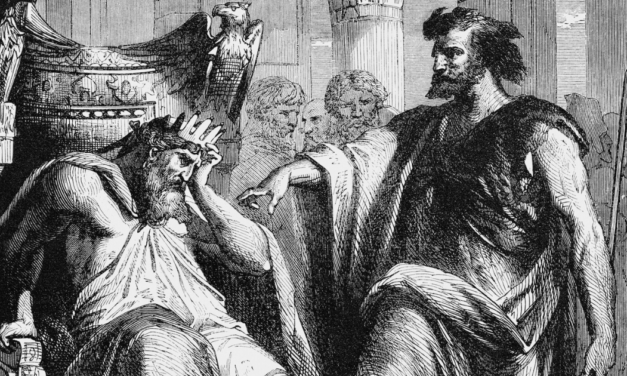This article first appeared in the Ask Hank column of the CHRISTIAN RESEARCH JOURNAL, volume 35, number 06 (2012). The full text of this article in PDF format can be obtained by clicking here. For further information or to subscribe to the CHRISTIAN RESEARCH JOURNAL go to: http://www.equip.org/christian-research-journal/
To say that Genesis is a literary masterpiece is to understate its elegance. With inspired brilliance, Moses interlaced a historical narrative with both symbolism and repetitive poetic structure, and he employed the powerful elements of story (characters, plot, tension, resolution) to set the foundation for the rest of redemptive revelation. The very chapter that references the fall also records the plan for restoration of fellowship—a plan that takes on definition with God’s promise to make Abram a great nation through which “all peoples on earth will be blessed” (Gen. 12:3).1 As such, Abram’s call is the divine antidote to Adam’s fall. Yet this is but a glimpse of the author’s genius. Genesis is forged so that its main message is as easy to remember as it is to recall.
To begin with, Genesis opens with a literary mnemonic (memory aid) by which we are daily reminded of God’s creative prowess. The first six days outline a hierarchy of creation that culminates in humanity as its crowning jewel. On the seventh day, the Creator, in whom we ultimately find our Sabbath, rests. As such, the history of creation is remembered and recalled through its association with the continuous seven-day cycle of life.
Furthermore, the rest of Genesis is structured in a way that it may be remembered using our ten fingers. With one hand we recall primeval history: the accounts of the heavens and the earth (2:4–4:26), Adam (5:1–6:8), Noah (6:9–9:29), Noah’s sons (10:1–11:9), and Shem, the father of the ancient Near East (11:10–26). With the other hand, we remember the accounts of Terah (father of Abraham, 11:27–25:11), Ishmael (25:12–18), Isaac (25:19–35:29), Esau (36:1–43), and Jacob, who is called Israel (37:2–50:26).
Finally, we should note that post-Gutenberg (printing press) we are primarily people of the printed page. We associate sound education with the capacity for reading and writing rather than memorizing and reciting. Not so the ancients. In their predominantly oral culture, people practiced the principles of memory. As such, Genesis contains many Hebrew symmetries, parallelisms, and sevenfold patterns. An example of a symmetrical pattern is found in the record of humanity’s first sin (2:4–3:24: the creation of man and woman; temptation by the serpent; sin in the center; and punishment of the serpent, woman, and man). The account of the seven-day creation (1:3–27) is a sevenfold pattern that contains a three-way parallel structure:
Day 1 light and Day 4 luminaries
Day 2 sky and sea and Day 5 sea and sky creatures
Day 3 land and Day 6 land creatures
Day 7 the Sabbath
From its seven-day opening through its tenfold pattern, Genesis serves as a unified and memorable prologue to the whole of redemptive history.2
Did Moses Write the Book of Genesis?
One complaint about the Genesis account of creation is that the first five books of the Bible, known collectively as the Pentateuch (“five-volumed book”), could not possibly have been written by Moses. Facts, however, say otherwise.
First, other biblical authors, including Joshua, Ezra, Daniel, and Paul, point squarely to Moses’ authorship of the Pentateuch. Indeed, the Pentateuch itself claims Moses as its author. In Exodus, for example, we read that “the Lord said to Moses, ‘Write down these words, for in accordance with these words I have made a covenant with you and with Israel.’ Moses was there with the Lord forty days and forty nights without eating bread or drinking water. And he wrote on the tablets the words of the covenant—the Ten Commandments” (34:27–28).
Furthermore, Jesus also placed the divine stamp of authenticity on Mosaic authorship when he said, “If you believed Moses, you would believe me, for he wrote about me. But since you do not believe what he wrote, how are you going to believe what I say?” (John 5:46–47; cf. John 1:45). Then, when Jesus spoke about marriage and divorce, he appealed directly to the words of Moses in Genesis 2 and added, “Moses permitted you to divorce your wives because your hearts were hard. But it was not this way from the beginning. I tell you that anyone who divorces his wife, except for marital unfaithfulness, and marries another woman commits adultery” (Matt. 19:8–9).
Finally, in addition to these testimonies from the Old Testament and the New Testament, other significant factors support Mosaic authorship. For example, the name Moses itself provides corroborating evidence for the exodus. The name is both rooted in Egyptian tradition and fits well with the exodus era.3 In addition, the author of Genesis, Exodus, Leviticus, Numbers, and Deuteronomy was clearly an eyewitness familiar with Egyptian names, words, customs, plants, animals, and even geography. This knowledge would have been difficult to come by unless the author was, in fact, an eyewitness to the remarkable events of the Egyptian captivity, the exodus, the forty-year sojourn in the wilderness, and the final encampment before entering the Promised Land.4
In sum, those who deny Moses’ authorship of the first five books of the Old Testament seem influenced more by antisupernatural bias than any biblical or historical evidence.5—Hank Hanegraaff
Hank Hanegraaff is president of the Christian Research Institute and host of the Bible Answer Man broadcast heard daily throughout the United States and Canada via radio, satellite radio Sirius-XM 131, and the Internet. For a list of stations airing the Bible Answer Man, or to listen online, log on to equip.org. Hank is the author of numerous books including Has God Spoken? Memorable Proofs of the Bible’s Divine Inspiration (Thomas Nelson, 2011), The Creation Answer Book (Thomas Nelson, 2012), and the forthcoming Afterlife (Worthy Publishing, spring 2013).
NOTES
- All Bible quotations are from the NIV1984.
- For further study, see David A. Dorsey, The Literary Structure of the Old Testament: A Commentary on Genesis–Malachi (Grand Rapids: Baker, 2004).
- As journalist Jeffrey Sheler explains, “The name is derived from the Egyptian mose (‘is born’), a term that often was combined—sometimes in modified form—with the name of a deity, as in the names of the pharaohs Thutmose (‘Thoth is born’) and Rameses (‘Ra is born’). Some scholars theorize that in the earliest traditions, Moses’ name also may have been linked with a deity. Or it simply may have stood alone in its original form as if to signify the one who gave birth to Israel as a covenant nation” (Jeffrey L. Sheler, Is the Bible True? [New York: HarperSanFrancisco, 1999], 81).
- For further study, see Hank Hanegraaff, Has God Spoken? Memorable Proofs of the Bible’s Divine Inspiration (Nashville: Thomas Nelson, 2011).
- This article is adapted from Hank Hanegraaff, The Creation Answer Book (Nashville: Thomas Nelson, 2012), 33–38.









